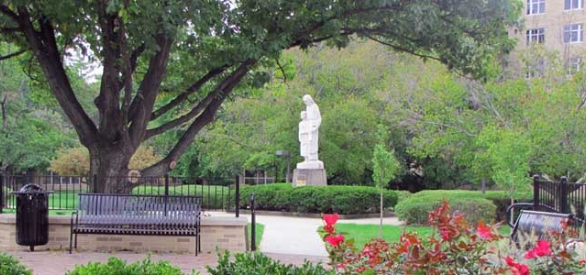A thoughtful reflection of finding faith and community remotely during this time.

Some Catholics feel obliged to attend Sunday Mass. I attend, participating as fully as I can, because it nourishes me. I find peace in the rituals that have been part of my life since childhood: the entrance procession, the prayers (some with familiar refrains), the offerings, the music, the readings, the reflections…and the community.
When the Catholic bishops of Ohio closed down parish churches partway through Lent to comply with best distancing practices, I applauded their decision, never imagining how long this directive would be in effect. In hindsight, I was naïve to assume we might be celebrating Holy Week with our parish friends.
To make it through this desert time, I would need prayer and community. Friends had been watching televised masses, some originating from their own parishes, some from around the world. When my father was in a nursing home, I realized as I heard televisions blaring from multiple rooms Sunday mornings, that televised Masses comforted many residents. Not for me, I thought. Too unnatural, more like a show than a prayerful time for me.
Already an accomplished convener of meetings through Zoom, I suggested to two friends and my husband that we have Zoom prayer at 10 on Sunday mornings. I volunteered to find the appropriate readings and responses online, one friend supplied recorded opening and closing hymns, we alternated selecting a closing prayer, and, in place of a homily, we slowly felt free to share our insights.
Possibly because of the circumstances, we began to notice details we had taken for granted over the years. Before Jesus exited the tomb, had he actually neatly folded the head wrapping and laid it rolled up in a separate place? How Jesus must have loved his friends Mary and Martha to drop everything to come quickly at their request to bring their brother Lazarus back from the dead. On that Lenten morning for our congregation of four, all missing our own family and friends as we distanced ourselves to “flatten the curve,” that reading held special meaning.
More than once over these weeks, I have been blindsided by the emotional impact of our virtual gatherings. Since we all practiced our assigned readings each week, I was taken aback the first week when I began to feel tears welling up as I read. Usually, I can anticipate when I might lose control during a particularly moving passage. But my reading wasn’t even that moving. Still I choked up partway through it.
Later in the day, I pondered the question “Why?” Why this reading? Why this morning?
As I continue to revisit the “whys,” this is what feels true: After weeks of fear, sadness and isolation, being together as a community in prayer, even remotely, was enough balm to unleash the powerful feelings I had been holding inside. My soul was letting me know that it was okay to cry.
Even though I was more isolated than I would have chosen, I realized that I had company in my prayers, my reflections and my tears.
Rabbi Harold Kushner in his classic book “Why Bad Things Happen to Good People” says it so well: “Prayer, when it is offered in the right way, redeems people from isolation. It assures them that they need not feel alone and abandoned. It lets them know that they are part of a greater reality, with more depth, more hope, more courage, and more of a future than any individual could have by himself.”
These days of teaching remotely, singing “Happy Birthday” to grandchildren over the internet--and aching to hug them, family, friends and students--are less than ideal in their forced isolation. I take comfort in knowing I am not really alone.

